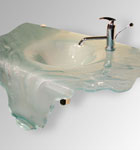
What inspired you to design and build this house?
Lawrence Scarpa: I’ve always been fascinated with natural systems and the poetry of living with nature. In Florida, where my wife and I both grew up, the Crackers in the early 1800s built houses as comfortably as they could, raising the floors off the ground and creating cross-ventilation. I thought it was beautiful the way they did that. We also were aware that in the 1940s and 1950s there was an influential group of Florida architects known as the Sarasota School. Among them, Paul Rudolph created beautiful and comfortable buildings in a harsh climate.
What green principles did you use in creating your Solar Umbrella House?
Angela Brooks: We used all of the passive strategies of orientation on the site to create an abundance of natural light. We used materials that are locally available and that have recycled content. To that we added more active systems that make the building perform better.
What was the biggest challenge in building the house?
AB: A lot of the technology was not readily available. At the time, nobody really understood solar systems. The city inspectors said if the utility company signed off on it, they would, too. And the utility company said the same about the city inspectors.

Has the house met your goals for energy efficiency?
LS: Yes, we pay less than $500 per year for electricity. That is mostly achieved through passive design. Every room has lots of natural light and cross ventilation. We rarely turn on the lights, except at night. If you ratchet down the need for electricity, then it is easy to provide generation that helps make that up.
The house appears to be very open. How did you achieve both privacy and natural light?
LS: The primary living spaces are somewhat sunken below the natural grade, and there is a garden wall near the property line so that when you’re looking out the windows, you’re really looking upward at the sky. And then on the upper floor we have fins and screens that provide privacy.
How practical is a home like this for the average homeowner?
LS: The concept of including sustainable materials is extremely practical. A lot of times a lack of knowledge is the enemy and people do what is familiar. For the masses that are still just catching on, this needs to be made law, and then everyone will do it. Fear of the unknown generally rules.



